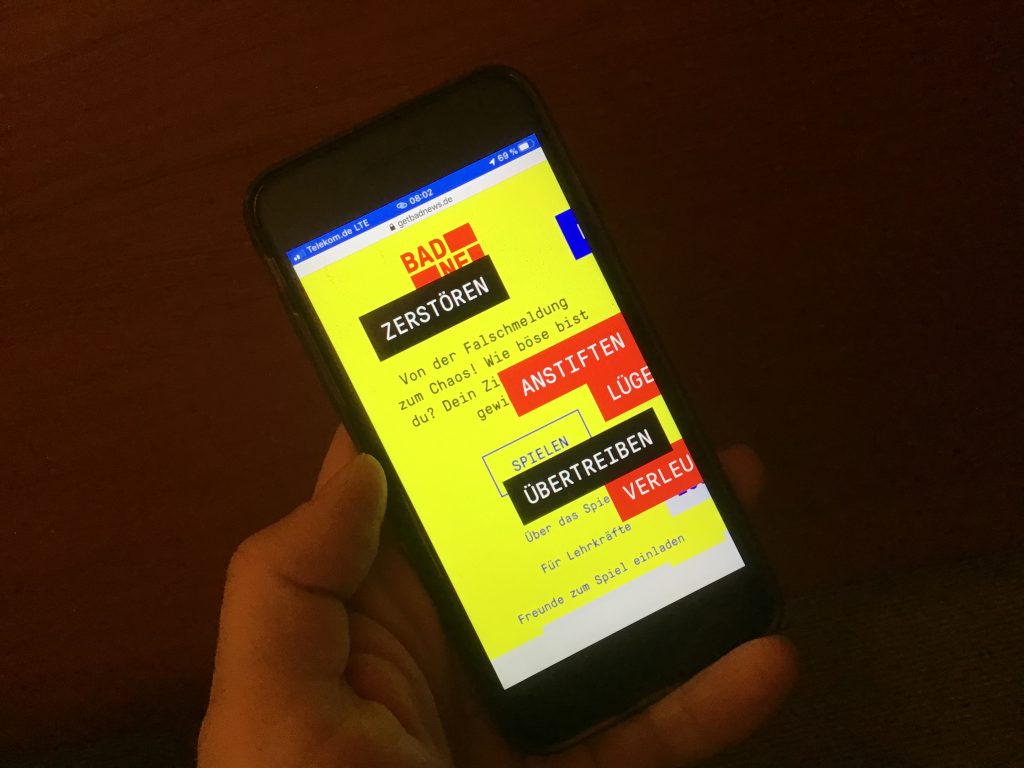Making Fake News and Co. a playful experience

Slip into the role of the bad guy and manipulate, rush, exaggerate, provoke… With „Bad News“ we become real false reporters and this with a good intention. Because the free online role play helps to understand and classify the mechanisms behind targeted disinformation on the Internet.
In this way, we gain insight into the methods and tactics used by false reporters to spread and polemicise their content and to play with people’s fears.
How does the game work?
„Play the bad guy and mess up the internet with disinformation“ is the first challenge of the game and the players should let off some frustration via Twitter before stealing an identity and launching a conspiracy theory. The goal: To win as many followers as possible without losing credibility.
The players are shown short texts, pictures or memes and have the possibility to react in a variety of ways. You can score points in two different ways: On the one hand you can increase the number of followers, on the other hand you can’t lose credibility.
Those who cleverly give answers like genuine false reporters are rewarded with both. But if you lie to the audience too blatantly, you lose credibility. Moral objections against it cost followers and the game encourages the players to dare more and to use the strategies of the false reporters: identity fraud, emotion, polarization, conspiracy, disrepute and trolls. For this there are then also badges in the classic reward system to be earned.

Objective of the game: Recognizing disinformation
Various actors – also in the political environment – try to influence people’s opinions by deliberately spreading misinformation. With the flood of information on the net, it is difficult to stay on top of things.
„The aim of the game is to educate people about fake news and misleading online messages and to sensitize them to an attentive use of the media.“ This is the opinion of the makers of the online game of the Dutch organisation DROG, who developed the game together with the University of Cambridge.
Disinformation does not end with pure false reports, but can have a very subtle effect. A message does not have to be completely fake to be manipulative and misleading. Playing with people’s feelings and fears is also very effective.
The online game aims to improve the awareness of disinformation by putting the players themselves in the role of false reporters.
Possible applications in training
„Bad News“ was originally developed for work with young people, but it also offers great added value in adult education: the game makes political education tangible and allows you to actively experience the strategies of disinformation on the net. The experience can be used to better expose even false reports and misleading content.
One way of using „Bad News“ in training is to let the participants play and then create opportunities for discussion:
- Where am I myself prone to fall for misinformation?
- How do these mechanisms affect trade union adult education and how do I deal with them?
- How are public opinions formed?
- And how can we become critical and responsible users?
All you need is internet access and a laptop, smartphone or tablet. The makers of the project provide an information sheet for teachers, which illuminates the individual strategies behind the project in more detail, provides scientific background and offers further links.
Data protection
The players act as if they are posting something. However, this happens in a fictitious setting. Nothing is published and the game is played anonymously. Anyone who wants to can also voluntarily take part in an online survey on the topic – also anonymously.
Author: Katharina Nierhoff
Translation: Astrid Donaubauer
Read original article in German

Dieses Werk ist lizenziert unter einer Creative Commons Namensnennung-NichtKommerziell-Weitergabe unter gleichen Bedingungen unter gleichen Bedingungen 3.0 Österreich Lizenz.
Volltext der Lizenz

